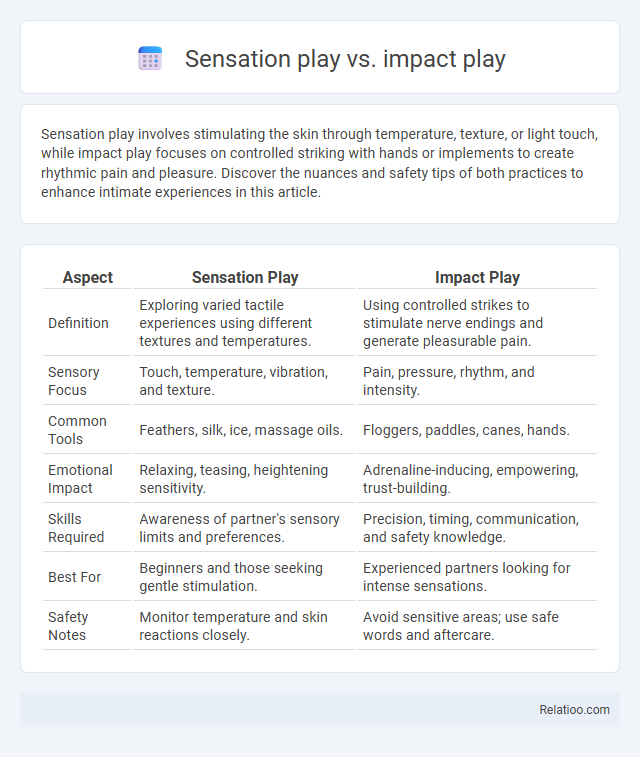Sensation play involves stimulating the skin through temperature, texture, or light touch, while impact play focuses on controlled striking with hands or implements to create rhythmic pain and pleasure. Discover the nuances and safety tips of both practices to enhance intimate experiences in this article.
Table of Comparison
| Aspect | Sensation Play | Impact Play |
|---|---|---|
| Definition | Exploring varied tactile experiences using different textures and temperatures. | Using controlled strikes to stimulate nerve endings and generate pleasurable pain. |
| Sensory Focus | Touch, temperature, vibration, and texture. | Pain, pressure, rhythm, and intensity. |
| Common Tools | Feathers, silk, ice, massage oils. | Floggers, paddles, canes, hands. |
| Emotional Impact | Relaxing, teasing, heightening sensitivity. | Adrenaline-inducing, empowering, trust-building. |
| Skills Required | Awareness of partner's sensory limits and preferences. | Precision, timing, communication, and safety knowledge. |
| Best For | Beginners and those seeking gentle stimulation. | Experienced partners looking for intense sensations. |
| Safety Notes | Monitor temperature and skin reactions closely. | Avoid sensitive areas; use safe words and aftercare. |
Understanding Sensation Play: An Overview
Sensation play involves exploring various tactile experiences to heighten physical awareness and emotional connection, using tools like feathers, silk, or ice to create gentle, stimulating sensations on the skin. Impact play, a subset of sensation play, focuses specifically on controlled striking with hands or implements such as paddles or floggers, aiming to produce a mix of pain and pleasure through calculated intensity. Understanding these distinctions helps you navigate safe and consensual experiences that enhance trust, communication, and sensory exploration within intimate settings.
What Is Impact Play? Core Concepts
Impact play involves striking the body with hands, paddles, floggers, or other implements to create pleasurable sensations through controlled physical impact. Its core concepts revolve around trust, consent, and communication to ensure safety and enjoyment, with an emphasis on varying intensity and targeting areas with flesh for optimal stimulation. You can explore different textures and rhythms to tailor the experience, distinguishing impact play from sensation play, which relies more on gentle touches and varied sensory inputs.
Key Differences Between Sensation Play and Impact Play
Sensation play involves stimulating the skin with various textures, temperatures, or gentle touches to heighten sensory awareness, while impact play focuses on delivering controlled strikes such as spanking or flogging to create a mix of pain and pleasure. The key difference lies in the intensity and type of stimulation: sensation play targets subtle, often soothing sensations, whereas impact play emphasizes rhythmic or forceful physical impact. You can explore and tailor both to enhance tactile experiences, balancing sensitivity with adrenaline for deeper connection and excitement.
Tools and Toys for Sensation Play
Tools and toys for sensation play include feathers, silk scarves, and ice cubes, designed to stimulate nerve endings with gentle touches or temperature contrasts. Impact play relies on implements like paddles, floggers, and crops to deliver controlled strikes that create varying degrees of tactile sensation. Your choice of tools should align with desired intensity and safety, ensuring pleasure and trust during exploration.
Equipment Commonly Used in Impact Play
Impact play primarily involves tools such as paddles, floggers, crops, and canes designed to deliver varying levels of sensation from light taps to intense strikes. These instruments are typically made from materials like leather, wood, silicone, or rubber, chosen for their durability and ability to create distinct tactile experiences. Sensation play, on the other hand, relies on equipment like feathers, ice cubes, and brushes to stimulate nerve endings gently, contrasting sharply with the forceful nature of impact play.
Safety Precautions in Sensation and Impact Play
Sensation play and impact play require strict safety precautions to prevent physical injury and ensure a consensual experience. In sensation play, using safe materials, testing temperature and pressure carefully, and maintaining clear communication are crucial to avoid skin damage or nerve injury. Impact play demands knowledge of anatomy to avoid hitting dangerous areas, employing proper implements, and constant check-ins with the partner to manage pain thresholds and prevent trauma.
Psychological Effects: Sensation vs. Impact Play
Sensation play stimulates your nervous system using gentle touches and varied textures to heighten sensitivity and arousal, promoting relaxation and emotional connection. Impact play involves controlled striking techniques that trigger adrenaline and endorphin release, enhancing pain tolerance and creating intense psychological stimulation. Both sensation and impact play influence your mental state differently, with sensation play fostering subtle emotional intimacy and impact play driving powerful physiological and psychological responses.
Consent and Communication: Foundational Principles
Consent and communication are essential in sensation play, impact play, and other BDSM activities to ensure participants' safety and enjoyment. Clear negotiation of boundaries, safe words, and continuous check-ins prevent misunderstandings and physical or emotional harm. Prioritizing informed consent fosters trust, allowing for exploration of sensations ranging from gentle touch to controlled impact within a respectful framework.
Exploring Aftercare Needs in Both Practices
Exploring aftercare needs in sensation play and impact play reveals distinct yet overlapping requirements tailored to physical and emotional recovery. Sensation play, relying on varied stimuli like temperature or textures, demands soothing techniques such as gentle touch and calming environments to ease sensory overstimulation. Impact play, involving strikes from implements like paddles or floggers, necessitates targeted care including skincare for bruises, hydration, and communication to address both physical marks and emotional processing.
Choosing What’s Right for You: Sensation Play or Impact Play
Choosing between sensation play or impact play depends on your comfort level and desired intensity. Sensation play involves exploring various textures and temperatures to stimulate nerve endings gently, while impact play focuses on controlled striking to create deeper physical sensations. Understanding your preferences and boundaries ensures a safe and enjoyable experience tailored to your personal desires.

Infographic: Sensation play vs Impact play
 relatioo.com
relatioo.com